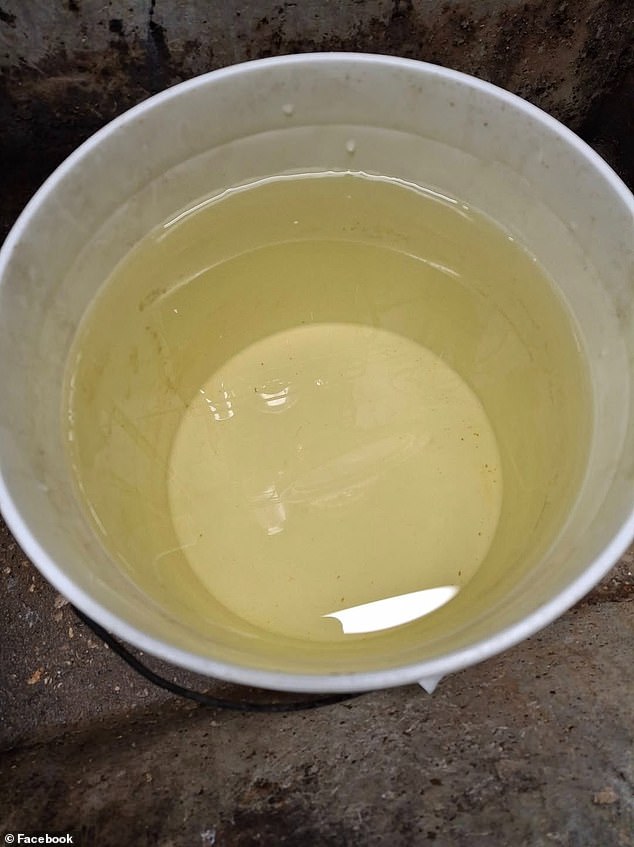Residents in two small Ohio cities have been left infuriated after they were told it’s safe to drink tap water that smells like mold and resembles urine.
Last week, officials in Talmadge and Akron – both about two hours outside of Columbus – told locals they are aware of the foul smelling water, but there is no need for concern.
‘Though noticeable, especially in hot water, the water is safe to drink, cook with, and use for bathing and pets,’ the city of Talmadge wrote in a Facebook post on July 23.
Meanwhile, Akron Mayor Shammas Malik notified its 85,000 residents that 6,600 of them had high levels of Haloacetic Acids (HAA5), a disinfection byproduct, in their water.
Despite sampling locations confirming the levels were surpassing maximum containment levels, Water Bureau Manager Scott Moegling, said Akron’s ‘water remains safe to drink and use as normal’.
Locals from both cities have shared their frustration with the water-related crisis, as one posted a frightening image of ‘piss looking water’ that came out of their tap in Akron.
‘I’m not going to drink this piss looking water. I will bet local restaurants are using it!,’ the angry Facebook user wrote.
Talmadge residents shared their rage about the situation directly under the city’s announcement about it as one wrote: ‘It is absolutely horrible!!’

Ohio residents in Akron and Talmadge are enraged at the disgusting water coming out of the faucets (pictured) as officials told them not to worry

Despite foul smelling and odd colored water, officials in both cities told locals drinking, bathing and using the tap water to cook is still safe. (Pictured: Stock image)
They continued to call out the town after officials said the smelly water was caused by two natural compounds, Methylisoborneol (MIB) and Geosmin.
According to the city, the compounds are ‘released during algae blooms in the reservoir’, but when algae dies, they ‘break open’ and create a ‘metallic smell’ after ‘reacting with chlorine during treatment’.
Many were not convinced the compounds were to blame for the horrendous odor.
‘And I highly doubt the chemicals they are using to remove the “smell” is non toxic !!!! I call shenanigans!,’ said one.
Another said the odor ‘smelled like your toilet’, as someone else added: ‘I can’t drink it the smell is too nasty. It tastes terrible too.’
Other Talmadge residents said this is not the first time people have had to live with bad water conditions.
‘Happens every year!,’ one commented.
Another shared: ‘Yep! Been happening for the last 40 years!’

According to the city, the compounds are ‘released during algae blooms in the reservoir,’ when algae died, they ‘break open’ and create a ‘metallic smell’ after ‘reacting with chlorine during treatment’


Akron (pictured) has a population of approximately 190,000. Three reservoirs take surface water from the Upper Cuyahoga River before being brought to Akron’s water supply
People in nearby Akron spoke out directly under Mayor Malik’s post where he showed maps outlining the ‘affected areas’ while stating the water remains ‘safe.’
‘There’s no immediate health risk, and your water is still safe to drink – no action is needed on your part,’ he wrote.
‘If you live in the affected areas (pictured in the maps below), keep an eye out for a notification in your mailbox in the coming weeks.’
His message did not appear to sit well with locals as they quickly called him out for his seemingly contradicting statement.
‘If they’re too high and need to be brought down how are they safe,’ a user wrote.
Another commented: ‘Already don’t drink it, now I don’t want to shower in it.’
‘Water is safe to drink and after a few days they will tell us oh no should be boiling it,’ said a local.
Stephanie Marsh, the director of communication for Akron, told Akron Beacon Journal the city is aware of the growing complaints.


Some Talmadge residents said this is not the first time people have had to live with bad water conditions. (Pictured: File photo)

Talmadge is home to a little more than 18,400 residents
‘Our administration is bringing legislation to Akron City Council (July 28) to purchase additional Jacobi Carbon to supplement the treatment process which should also help with the odor/taste issues,’ Marsh said.
Three reservoirs take surface water from the Upper Cuyahoga River before being brought to Akron’s water supply.
Akron has a population of approximately 190,000 while Talmadge is home to a little more than 18,400.
Moldy-smelling water can cause a slew of health conditions, including respiratory issues, allergic reactions, and in some cases, infections.
Yellow tap water can point toward high iron levels, sediment disturbances and corroded pipes.
Daily Mail contacted Akron Water Supply Bureau and the City of Tallmadge for further comment.

